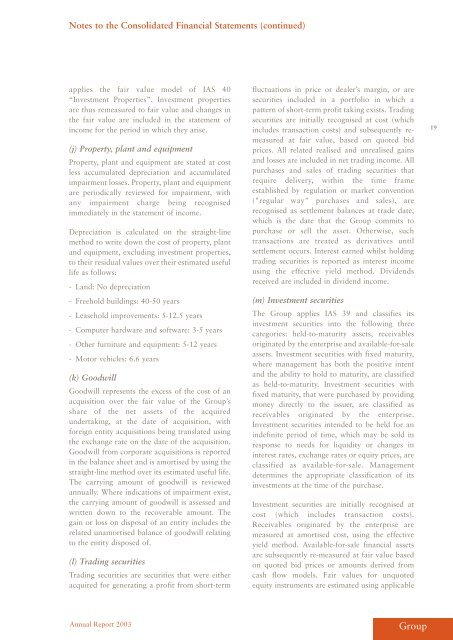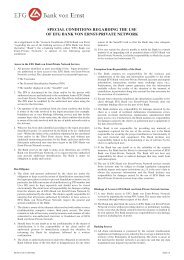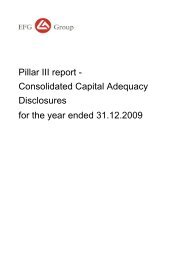as at December 31, 2003 - EFG Bank Group
as at December 31, 2003 - EFG Bank Group
as at December 31, 2003 - EFG Bank Group
Create successful ePaper yourself
Turn your PDF publications into a flip-book with our unique Google optimized e-Paper software.
Notes to the Consolid<strong>at</strong>ed Financial St<strong>at</strong>ements (continued)<br />
applies the fair value model of IAS 40<br />
“Investment Properties”. Investment properties<br />
are thus reme<strong>as</strong>ured to fair value and changes in<br />
the fair value are included in the st<strong>at</strong>ement of<br />
income for the period in which they arise.<br />
(j) Property, plant and equipment<br />
Property, plant and equipment are st<strong>at</strong>ed <strong>at</strong> cost<br />
less accumul<strong>at</strong>ed depreci<strong>at</strong>ion and accumul<strong>at</strong>ed<br />
impairment losses. Property, plant and equipment<br />
are periodically reviewed for impairment, with<br />
any impairment charge being recognised<br />
immedi<strong>at</strong>ely in the st<strong>at</strong>ement of income.<br />
Depreci<strong>at</strong>ion is calcul<strong>at</strong>ed on the straight-line<br />
method to write down the cost of property, plant<br />
and equipment, excluding investment properties,<br />
to their residual values over their estim<strong>at</strong>ed useful<br />
life <strong>as</strong> follows:<br />
- Land: No depreci<strong>at</strong>ion<br />
- Freehold buildings: 40-50 years<br />
- Le<strong>as</strong>ehold improvements: 5-12.5 years<br />
- Computer hardware and software: 3-5 years<br />
- Other furniture and equipment: 5-12 years<br />
- Motor vehicles: 6.6 years<br />
(k) Goodwill<br />
Goodwill represents the excess of the cost of an<br />
acquisition over the fair value of the <strong>Group</strong>’s<br />
share of the net <strong>as</strong>sets of the acquired<br />
undertaking, <strong>at</strong> the d<strong>at</strong>e of acquisition, with<br />
foreign entity acquisitions being transl<strong>at</strong>ed using<br />
the exchange r<strong>at</strong>e on the d<strong>at</strong>e of the acquisition.<br />
Goodwill from corpor<strong>at</strong>e acquisitions is reported<br />
in the balance sheet and is amortised by using the<br />
straight-line method over its estim<strong>at</strong>ed useful life.<br />
The carrying amount of goodwill is reviewed<br />
annually. Where indic<strong>at</strong>ions of impairment exist,<br />
the carrying amount of goodwill is <strong>as</strong>sessed and<br />
written down to the recoverable amount. The<br />
gain or loss on disposal of an entity includes the<br />
rel<strong>at</strong>ed unamortised balance of goodwill rel<strong>at</strong>ing<br />
to the entity disposed of.<br />
(l) Trading securities<br />
Trading securities are securities th<strong>at</strong> were either<br />
acquired for gener<strong>at</strong>ing a profit from short-term<br />
Annual Report <strong>2003</strong><br />
fluctu<strong>at</strong>ions in price or dealer’s margin, or are<br />
securities included in a portfolio in which a<br />
p<strong>at</strong>tern of short-term profit taking exists. Trading<br />
securities are initially recognised <strong>at</strong> cost (which<br />
includes transaction costs) and subsequently reme<strong>as</strong>ured<br />
<strong>at</strong> fair value, b<strong>as</strong>ed on quoted bid<br />
prices. All rel<strong>at</strong>ed realised and unrealised gains<br />
and losses are included in net trading income. All<br />
purch<strong>as</strong>es and sales of trading securities th<strong>at</strong><br />
require delivery, within the time frame<br />
established by regul<strong>at</strong>ion or market convention<br />
("regular way" purch<strong>as</strong>es and sales), are<br />
recognised <strong>as</strong> settlement balances <strong>at</strong> trade d<strong>at</strong>e,<br />
which is the d<strong>at</strong>e th<strong>at</strong> the <strong>Group</strong> commits to<br />
purch<strong>as</strong>e or sell the <strong>as</strong>set. Otherwise, such<br />
transactions are tre<strong>at</strong>ed <strong>as</strong> deriv<strong>at</strong>ives until<br />
settlement occurs. Interest earned whilst holding<br />
trading securities is reported <strong>as</strong> interest income<br />
using the effective yield method. Dividends<br />
received are included in dividend income.<br />
(m) Investment securities<br />
The <strong>Group</strong> applies IAS 39 and cl<strong>as</strong>sifies its<br />
investment securities into the following three<br />
c<strong>at</strong>egories: held-to-m<strong>at</strong>urity <strong>as</strong>sets, receivables<br />
origin<strong>at</strong>ed by the enterprise and available-for-sale<br />
<strong>as</strong>sets. Investment securities with fixed m<strong>at</strong>urity,<br />
where management h<strong>as</strong> both the positive intent<br />
and the ability to hold to m<strong>at</strong>urity, are cl<strong>as</strong>sified<br />
<strong>as</strong> held-to-m<strong>at</strong>urity. Investment securities with<br />
fixed m<strong>at</strong>urity, th<strong>at</strong> were purch<strong>as</strong>ed by providing<br />
money directly to the issuer, are cl<strong>as</strong>sified <strong>as</strong><br />
receivables origin<strong>at</strong>ed by the enterprise.<br />
Investment securities intended to be held for an<br />
indefinite period of time, which may be sold in<br />
response to needs for liquidity or changes in<br />
interest r<strong>at</strong>es, exchange r<strong>at</strong>es or equity prices, are<br />
cl<strong>as</strong>sified <strong>as</strong> available-for-sale. Management<br />
determines the appropri<strong>at</strong>e cl<strong>as</strong>sific<strong>at</strong>ion of its<br />
investments <strong>at</strong> the time of the purch<strong>as</strong>e.<br />
Investment securities are initially recognised <strong>at</strong><br />
cost (which includes transaction costs).<br />
Receivables origin<strong>at</strong>ed by the enterprise are<br />
me<strong>as</strong>ured <strong>at</strong> amortised cost, using the effective<br />
yield method. Available-for-sale financial <strong>as</strong>sets<br />
are subsequently re-me<strong>as</strong>ured <strong>at</strong> fair value b<strong>as</strong>ed<br />
on quoted bid prices or amounts derived from<br />
c<strong>as</strong>h flow models. Fair values for unquoted<br />
equity instruments are estim<strong>at</strong>ed using applicable<br />
<strong>Group</strong><br />
19





